Wall push-ups are a great bodyweight exercise that can help strengthen your chest, shoulders, and triceps.
They can also help improve your posture and stability and increase your upper body strength and endurance.
Standing push-ups are a low-impact exercise that people of all fitness levels can do. So, they are a good choice for people who are just starting to do strength training.
This guide provides an overview of the benefits of wall push-ups, how to do them properly, and the muscles worked during them.
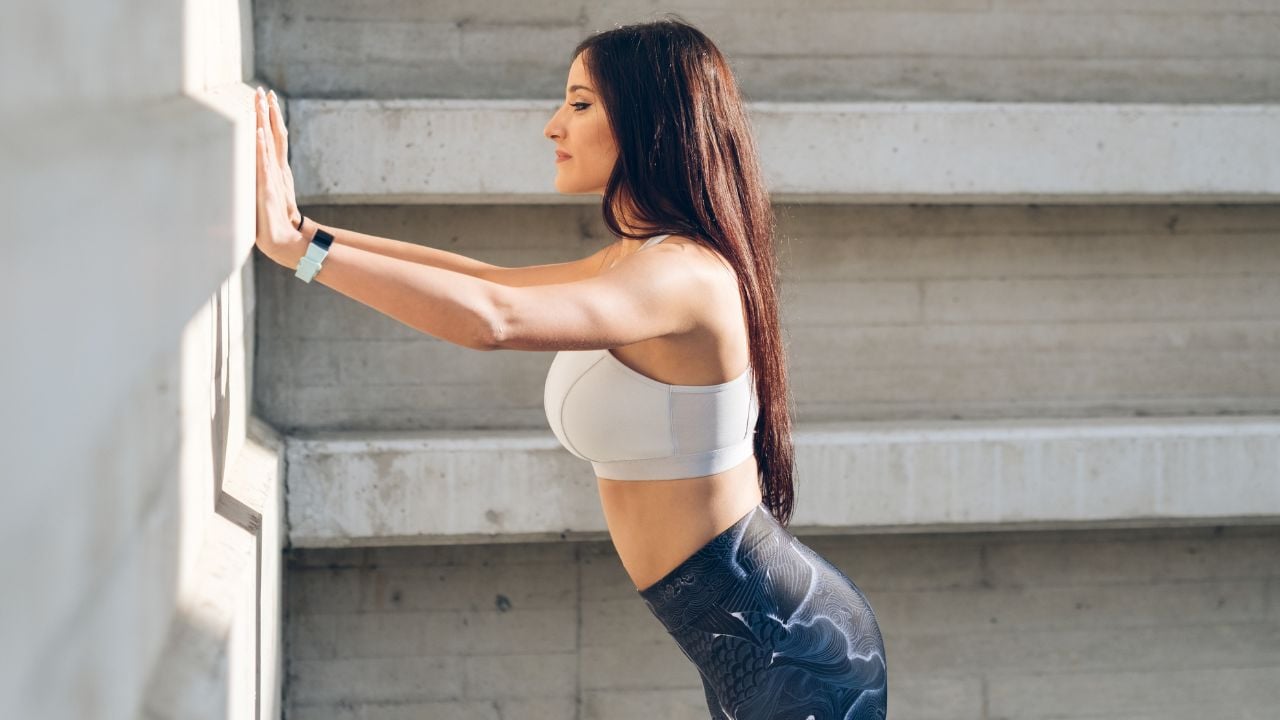
- What Are Wall Push-Ups
- Benefits of Wall Pushups
- Muscle Worked During Wall Push-Ups
- How To Do Wall Push-Ups
- Wall Push Up Form And Tips
- Modifications and Variations of Wall Push-Ups
- 1. Close Grip Wall Push-Ups
- 2. Wide Grip Wall Ups
- 3. Plyometric Wall Push-Ups
- 4. One-Armed Wall Push-Ups
- 5. Single-leg Wall Push-Ups
- 6. Decline Wall Push-Ups
- FAQs
- Wall Push-Up Benefits For Females
- Are wall push-ups effective?
- How many wall push ups equal 1 push up?
- What will happen if I do 100 Wall pushups a day?
- How Many calories are burned During a wall push?
- How many wall pushups should I do a day?
- How Many Wall Push-Ups Should I Do A Day
- Wall Push-Ups For Flabby Arms
- Wall Push-Up Vs. Knee Push-Up
What Are Wall Push-Ups
A wall push-up is a modified push-up exercise performed against a wall instead of the floor. Wall push-ups are gentler on the wrists and lower back compared to standard push-ups.
It is a beginner-friendly exercise that helps build upper body strength, improve core stability, and enhance posture.
Wall push-ups are a versatile exercise that can be adapted to various fitness levels by adjusting the distance from the wall and the angle of the body.
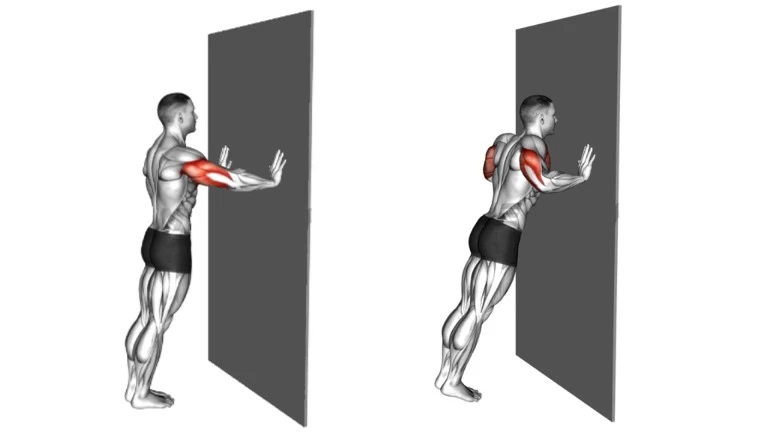
Benefits of Wall Pushups
Some other benefits of wall push-ups include:
- They can be done anytime, anywhere, as long as you have a wall to push against.
- They’re a safe and effective way to work your upper body muscles without putting unnecessary strain on your joints.
- They can help improve your overall muscle tone and definition. Doing it can be a powerful full-body workout and help to burn more calories.
- They’re a great way to build strength and improve your athletic performance in other activities.
- Wall push-ups are also considered a compound exercise because they train multiple muscle groups simultaneously.
- One benefit is that they can also strengthen the cardiovascular system by making your heart work harder.
- You don’t need any special equipment to practice the push-ups workout. All you require is the right technique and some willpower.
- Additionally, wall pushups may benefit people with mild wrist pain by reducing the load on the wrist joints.
- It may also be beneficial for those with lower back pain or elbow pain as well.
Overall, wall push-ups are a simple and effective way to strengthen your upper body and improve your overall fitness level.
Muscle Worked During Wall Push-Ups
Wall pushups are a full-body workout. Pushups are not just for the upper body. They also work many muscles to keep the position and movement stable.
Wall push-ups primarily work the chest muscles (pectoralis major and minor), the triceps and the front of the shoulders (anterior deltoids).
They also engage the core muscles, back muscles, serratus anterior as they help to stabilize the body during the exercise.
To some extent, this exercise also employs your lower body muscles, such as your glutes, quads, and calves, for stability.
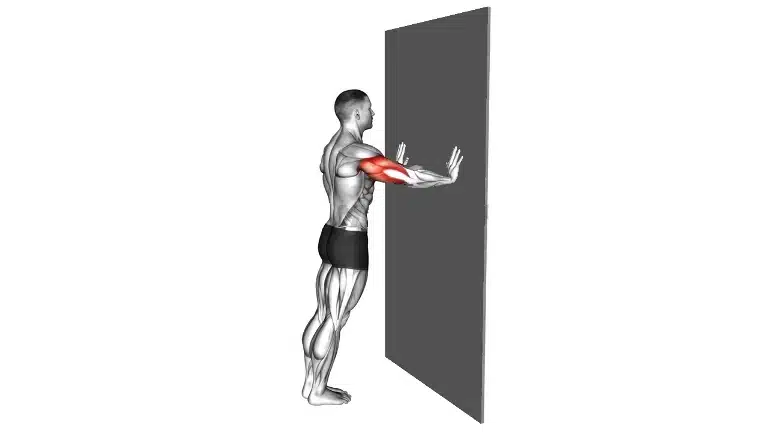
How To Do Wall Push-Ups
Here are some tips for starting a wall push-up at-home workout routine.
- Before you do wall push-ups, you need to find the right wall space.
- Stand facing a wall, with your feet shoulder-width apart and your hands placed on the wall at shoulder height.
- Place your hands against the wall with your body straight and your legs a few feet behind.
- Ensure that your body draws a triangle together with the wall and the floor.
- Keep your feet firmly fixed to the ground.
- Bend your elbows and lower your body towards the wall.
- Push your body back up to the starting position, straightening your arms.
- Repeat for the desired number of reps.
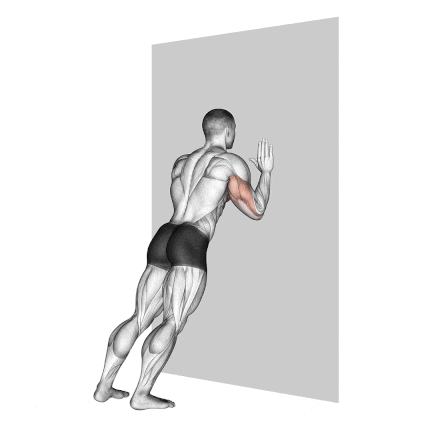
Wall Push Up Form And Tips
The following tips will help you get the most out of your standing push-ups:
- To ensure proper positioning, measure the distance between the wall and the toes.
- Most people should be approximately an arm’s length away from the wall’s surface—not too close or too far.
- Make sure your feet are centered and hip-width apart.
- Keep your chest up, your head facing forward, and your back slightly arched.
- Keep your body straight and your core engaged to maintain proper form.
- Keep your elbows close to your body as you lower and raise yourself.
- If this is too easy, you can try doing the push-ups with your feet farther away from the wall to increase the difficulty.
- If this is too difficult, you can try doing the push-ups with your feet closer to the wall. Or you can do modified push-ups on your knees instead of your toes.
- Remember to breathe deeply and evenly throughout the exercise.
Modifications and Variations of Wall Push-Ups
When you first begin, you may find it to be difficult. In this case, modifying your form and making the exercise easier can be helpful.
Start with knee wall push-ups. Additionally, you can always reduce the intensity by decreasing the angle of your body against the wall.
When you can do 15-20 wall push-ups in a row, or you may want to increase the intensity of push-ups, then try doing the incline push-ups on box and knee push-ups.
There are several variations of standing push-ups that you can try to challenge yourself and keep your workouts interesting. Here are a few examples:
1. Close Grip Wall Push-Ups
Close grip wall push-ups are a more challenging variation, and they emphasize the triceps and shoulders more.
They’re a good choice for those looking to increase upper chest and tricep size.
How To Do It
- Stand facing a wall with your feet shoulder-width apart.
- Your hands should be placed on the wall at shoulder height.
- Bring your hands closer together to be about 6–8 inches apart.
- Bend your elbows and lower your body towards the wall.
- Push your body back up to the starting position.
2. Wide Grip Wall Ups
Wide grip wall push-ups are more challenging than standard standing push-ups, which place greater emphasis on the chest muscles.
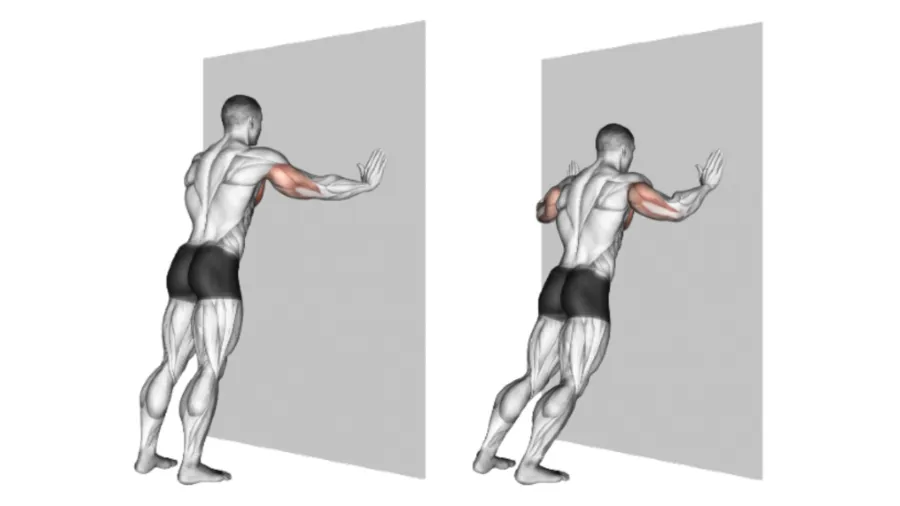
How To Do It
- Stand with your feet shoulder-width apart and your hands on the wall at shoulder height.
- Spread your hands out wider than shoulder-width apart.
- Bend your elbows and lower your body towards the wall.
- Push your body back up to the starting position.
3. Plyometric Wall Push-Ups
Plyometric wall push-ups, or clapping push-ups, are a type of plyometric exercise. During this exercise, you push off the wall hard enough to lift your hands off the wall and clap before returning to where you started.
This exercise is intended to increase power and speed in the upper body.
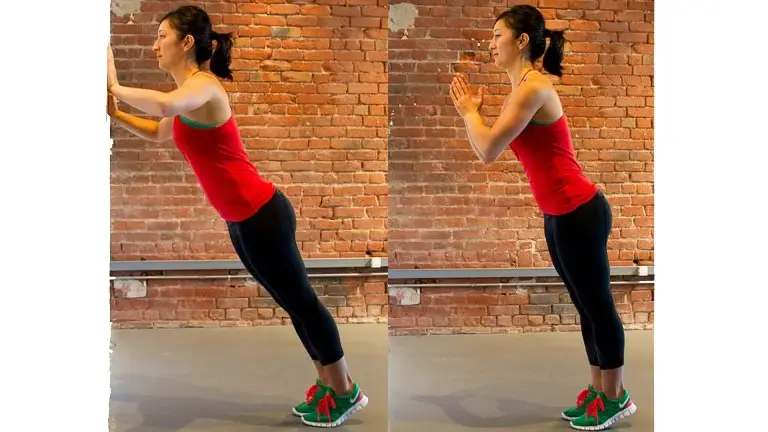
How To Do It
- Stand facing a wall with your hands on the wall at shoulder-width apart.
- Bend your arms to lower your body towards the wall.
- As you push back up, explosively push off the wall and lift your hands off the ground, clapping them together before returning to the starting position.
- Land softly on the ground and repeat for the desired number of reps.
4. One-Armed Wall Push-Ups
One arm is also known as unilateral wall-ups. These push-ups can be performed with one arm while the other arm is extended out to the side or resting on the hip.
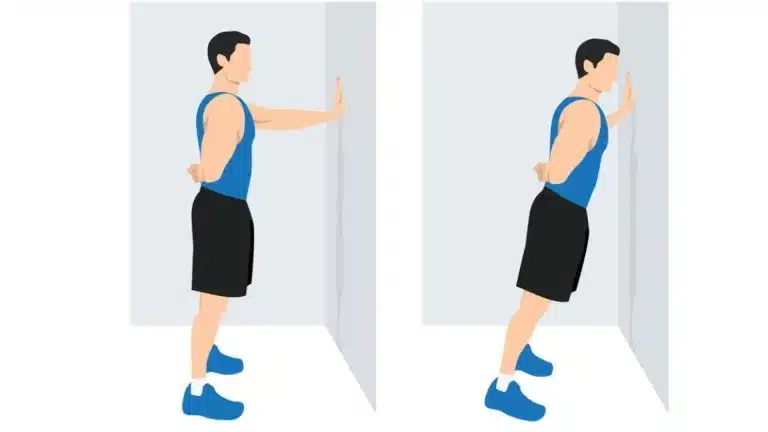
How To Do It
- Stand facing the wall with your feet shoulder-width apart and one hand on the wall.
- Extend the other arm out to the side or rest it on your hip.
- Lower your body towards the wall by bending the arm that is on the wall.
- Push your body back up to the starting position.
5. Single-leg Wall Push-Ups
The one-leg wall push-ups are a variation of the wall push-ups. To do this exercise, lift one leg off the ground and extend the other leg to the side.

How To Do It
- Stand facing a wall with one foot on the ground and the other leg extended out to the side.
- Place your hands on the wall at shoulder-width apart.
- Lower your body towards the wall by bending your arms.
- Straighten your arms by pushing your body back up to the starting position.
6. Decline Wall Push-Ups
To do decline wall push-ups, place your feet on a raised surface (such as a step or bench) and do the push-ups with your hands on the floor.
This will make the exercise more challenging and place more emphasis on the lower chest and triceps.
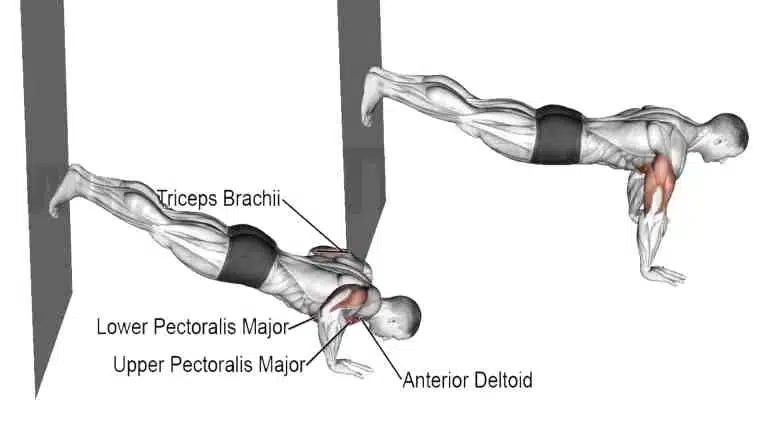
Remember to start slowly and gradually increase the difficulty of these variations as you get stronger. It’s also important to listen to your body and take breaks when needed.
FAQs
Wall Push-Up Benefits For Females
- Builds upper body strength. This can help with daily activities like carrying groceries or children.
- Enhances muscle tone and definition in the arms.
- Contributes to better posture by engaging upper body muscles.
- It is gentle on joints, making it suitable for those with sensitivities.
- This can contribute to weight loss or management goals.
- They are beginner-friendly and provide an entry point to strength training for females.
- It can be done anywhere with a flat surface, offering a time-efficient workout.
- Improves strength for daily activities involving pushing or lifting.
- Progression in wall push-ups enhances confidence in fitness routines.
- Serves as a foundational exercise for more advanced upper-body workouts.
Are wall push-ups effective?
Yes, wall push-ups can strengthen your upper body muscles, including your chest, triceps, and shoulders.
They are low-impact exercises that are suitable for people of all fitness levels. It is a good choice for those who are just starting out with strength training.
To make wall push-ups more effective, it’s important to maintain proper form and do the exercise with enough intensity to challenge your muscles.
How many wall push ups equal 1 push up?
It’s difficult to say exactly how many wall push-ups are equivalent to one standard push-up, as it depends on the individual’s strength and fitness level.
In general, doing 2 to3 wall push-ups is about the same as doing 1 regular push-up.
However, wall push-ups are easier than standard push-ups because they place less stress on the muscles and joints.
To compare the difficulty of wall push-ups to standard push-ups, you can try doing both exercises and see how many reps you can do of each.
You may find that you can do more wall push-ups than standard push-ups or only a few reps of each before feeling fatigued.
What will happen if I do 100 Wall pushups a day?
Doing 100 wall push-ups daily could be a good way to strengthen your upper body, including your chest, triceps, and shoulders.
However, it’s important to remember that every person is different, and the number of push-ups you can do will depend on your current strength and fitness level.
If you’re starting out with wall push-ups, building up gradually is important to avoid overloading your muscles and risking injury.
You can start by doing a few sets of wall push-ups with a short rest in between, and gradually increase the number of reps and sets as you get stronger.
How Many calories are burned During a wall push?
The number of calories burned during wall push-ups depends on various factors, including weight, age, and intensity level. Here are a few estimates based on a general calorie calculator:
- A person weighing 125 lbs (57 kg) can expect to burn around 70 calories in 30 minutes.
- A person weighing 155 lbs (70 kg) can expect to burn around 87 calories in 30 minutes.
- A person weighing 185 lbs (84 kg) can expect to burn around 105 calories in 30 minutes.
These estimates are based on moderate-intensity wall push-ups and may vary depending on your individual circumstances.
It’s important to note that the number of calories burned during exercise is just one aspect of overall weight management.
A healthy diet and regular physical activity are both essential for maintaining a healthy weight.
How many wall pushups should I do a day?
The number of wall push-ups you should do each day will depend on your current strength, fitness level, and goals.
Here are a few general guidelines to consider:
- If you’re starting out with push-ups, you can start with a few reps and gradually increase as you get stronger.
- If you want to maintain your current strength and muscle mass, you can aim to do at least a few sets of wall push-ups a few times a week.
- If you want to increase your strength and muscle mass, you can aim to do more standing push-ups each week. Focus on progressively increasing the difficulty of the exercise.
Mastering standing push-ups doesn’t have to be hard! This guide tells you how to do this simple but powerful workout.
How Many Wall Push-Ups Should I Do A Day
As a beginner, you can start with 10–15 reps per set and do 3–4 sets. Then, gradually increase the number of reps and sets as you get stronger.
As you become more comfortable and stronger, you can do 2–4 sets of 20-40 wall push-ups.
Many people have tried doing 100 wall push-ups per day for a month and have seen improvements in their push-up form and upper body strength.
Wall Push-Ups For Flabby Arms
Wall push-ups are a beneficial exercise for targeting flabby arms. Keep in mind that You can’t spot-treat fat loss, but improving muscle tone in the upper body can help create a tight and toned appearance. They are combined with a proper diet and regular exercise.
Wall Push-Up Vs. Knee Push-Up
Wall and knee push-ups are bodyweight exercises that target the upper body, including the chest, triceps, and shoulders.
However, there are a few differences between these two exercises:
1. Difficulty
Wall push-ups are generally easier than knee push-ups because they place less stress on the muscles and joints.
This makes wall push-ups a good choice for beginners or those just starting out with strength training.
Knee push-ups, on the other hand, are a bit more challenging and can help to increase upper body strength and endurance.
2. Form
In a wall push-up, you start standing at shoulder height with your hands on the wall.
You start in a plank position on your hands and knees in a knee push-up.
3. Muscles worked
Both exercises work the chest, triceps, and shoulders but may engage these muscles slightly differently depending on your body position.
For example, a wall push-up may emphasize the triceps and shoulders more, while a knee push-up may place more emphasis on the chest.
Both wall push-ups and knee push-ups can be effective exercises for strengthening the upper body.
Reference
- Castelein B, Cagnie B, Parlevliet T, Cools A. Serratus anterior or pectoralis minor: Which muscle has the upper hand during protraction exercises? Man Ther. 2016 Apr;22:158-64. doi: 10.1016/j.math.2015.12.002. Epub 2015 Dec 22. PMID: 26749459.
- Marcolin G, Petrone N, Moro T, Battaglia G, Bianco A, Paoli A. Selective Activation of Shoulder, Trunk, and Arm Muscles: A Comparative Analysis of Different Push-Up Variants. J Athl Train. 2015 Nov;50(11):1126-32. doi: 10.4085/1062-6050-50.9.09. Epub 2015 Oct 21. PMID: 26488636; PMCID: PMC4732391.

Manish brings over 10 years of hands-on experience in weight lifting and fat loss to fitness coaching. He specializes in gym-based training and has a lot of knowledge about exercise, lifting technique, biomechanics, and more.
Through “Fit Life Regime,” he generously shares the insights he’s gained over a decade in the field. His goal is to equip others with the knowledge to start their own fitness journey.
